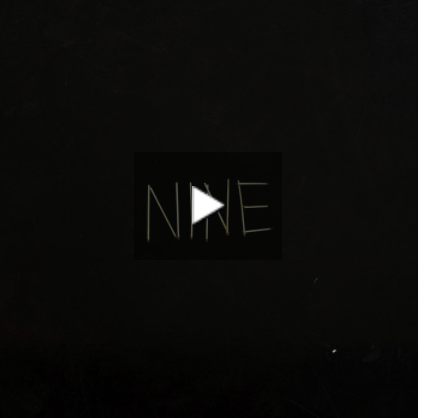Emery Marc Petchauer
Not sure if anyone feels the same way, but the difference between (Name, date) and (e.g., Name, date) is so crucial.
Ready to go for DEMC at DIME. The topic: Adding simple DJ cuts to tracks — skill and philosophy. Free online stream if you can find it!

This creative non fiction piece about mathematics, teaching, and the wonder of infinity had me tearing up both times I read it. I can’t wait to read it a third.
I try holding not too tightly onto specific sentences in early drafts. That’s because I know things will get chopped and changed over time. But there’s one sentence in this essay I’m writing that I love so much. Too much, in fact. It’s gonna get me into trouble, have me saying something nasty to any editor who suggests I change even one word in it. This kind of love will have me giving up the whole essay just to save this little sentence of my heart.
Here is an art and image heavy edition of my newsletter I sent out on Sunday. There are so many good pieces in the BROOD exhibit at MOCADetroit right now.
Whew! I’m glad somebody said it! Print this out and staple it to the front of every social science research methods book.
The problem with the ‘gap in the literature’ feedproxy.google.com/~r/Impact…
This conversation between John Morrison and King Britt has so many gems in it about teaching, teaching music, teaching Black electronic music, and more. But I love this last part the most and not just because they mention Dilla.
JM: Can you give me a final word about what you’ve learned about how Black folks engage with electronic music from teaching this course?
KB: For us, these are just tools to enhance what we already have in our existence, in our DNA, as far as rhythm. So if you want to talk about Dilla – the drum machine and samplers enhanced what he already had in him, right? The way he beat programs, not using quantification on everything, he’s putting his humanness in. All Black folks put their humanness into the electronic instrument. The tools propel what our sound is to a whole other level.
I’ve bookmarked 535 items in the last 2 years. Here’s all of them on my Pinboard. My most common tags are Arts, Music, Activism, and Sound. But there’s some great stuff under Fun. And the tag Dilla has some delights as well.
I woke up with this idea. There should be a bot that makes 5-7-5 pattern poems from Erykah Badu lyrics. The bot would be called Erykah Haiku.
🎶 Now I might have to make a whole EP of these M.O.P. slow jams.
Piece by Bryce Detroit at the MOCAD, part of the BROOD exhibit. It’s the first piece you see entering the exhibit, in fact - not an accident.

Theories of Change in Racial Consciousness: A Thought Exercise
This is a thought exercise I developed through the Race, Pedagogy, & Lit workshop series at Michigan State University.* The exercise tries to create dialogue and understanding among colleagues who might hold similar commitments to antiracism but take very different steps toward antiracist outcomes in courses and around campus. In a charitable environment, such colleagues are eager to understand one another. In an uncharitable environment, such colleagues may be suspicious of one another. The exercise is geared toward either environment.
Ground zero is this question:
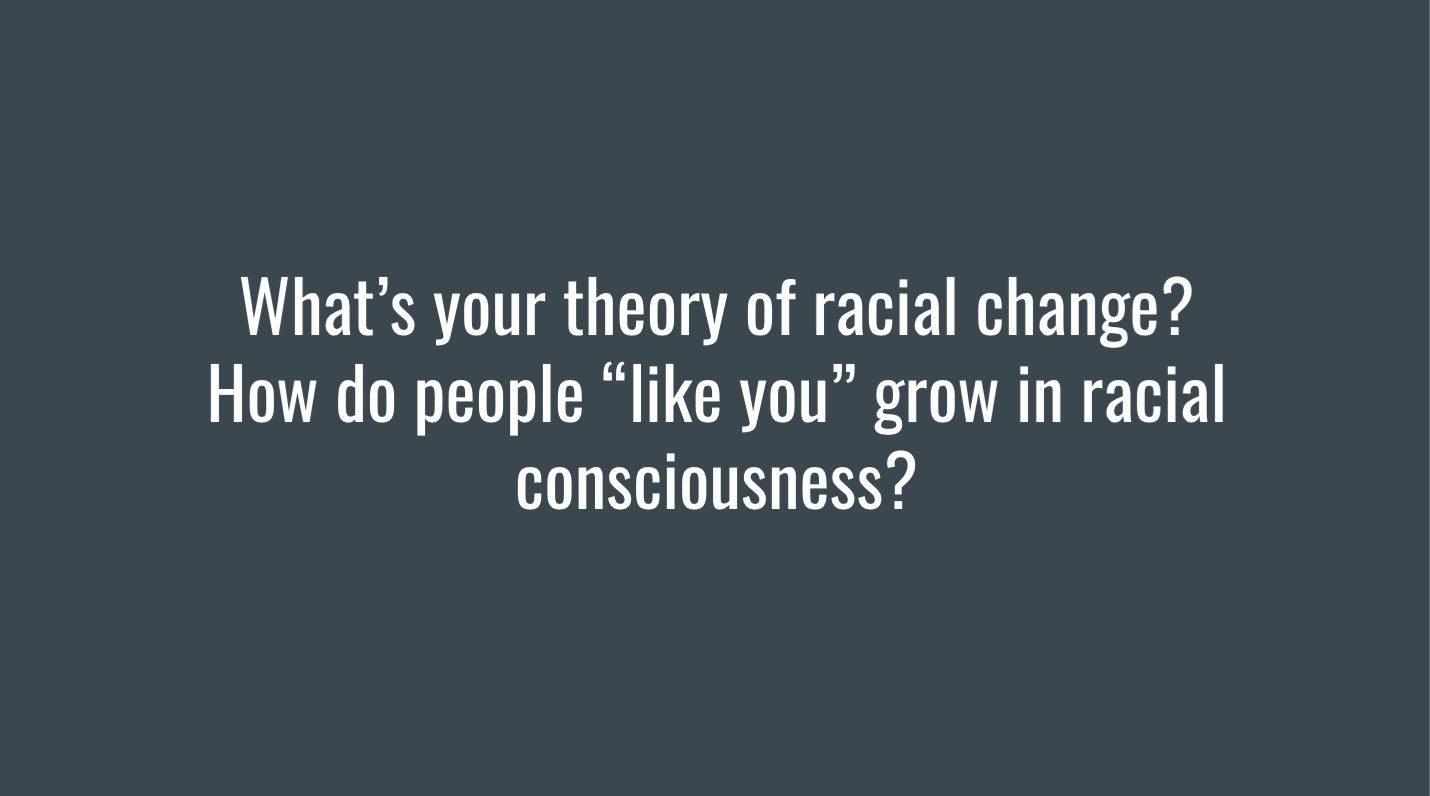
This question draws from Eve Tuck’s article “Suspending Damage,” which discusses theories of change in social science research. The social science context isn’t important. Rather, it’s important people think about the tacit theories of change they have adopted regarding how people like themselves grow in racial consciousness.
The framing of this question toward people “like you” is useful. First, it allows people to take up the question in a range of ways. Second, it allows facilitators to prompt in certain directions, like asking white folks to think about how other white folks grow in racial consciousness.
We then link this question with two others relevant to the campus context. These three questions and the possible answers make up the thought matrix of the exercise. How you answer these questions reveals key components about the overall theory of change that guides your actions.
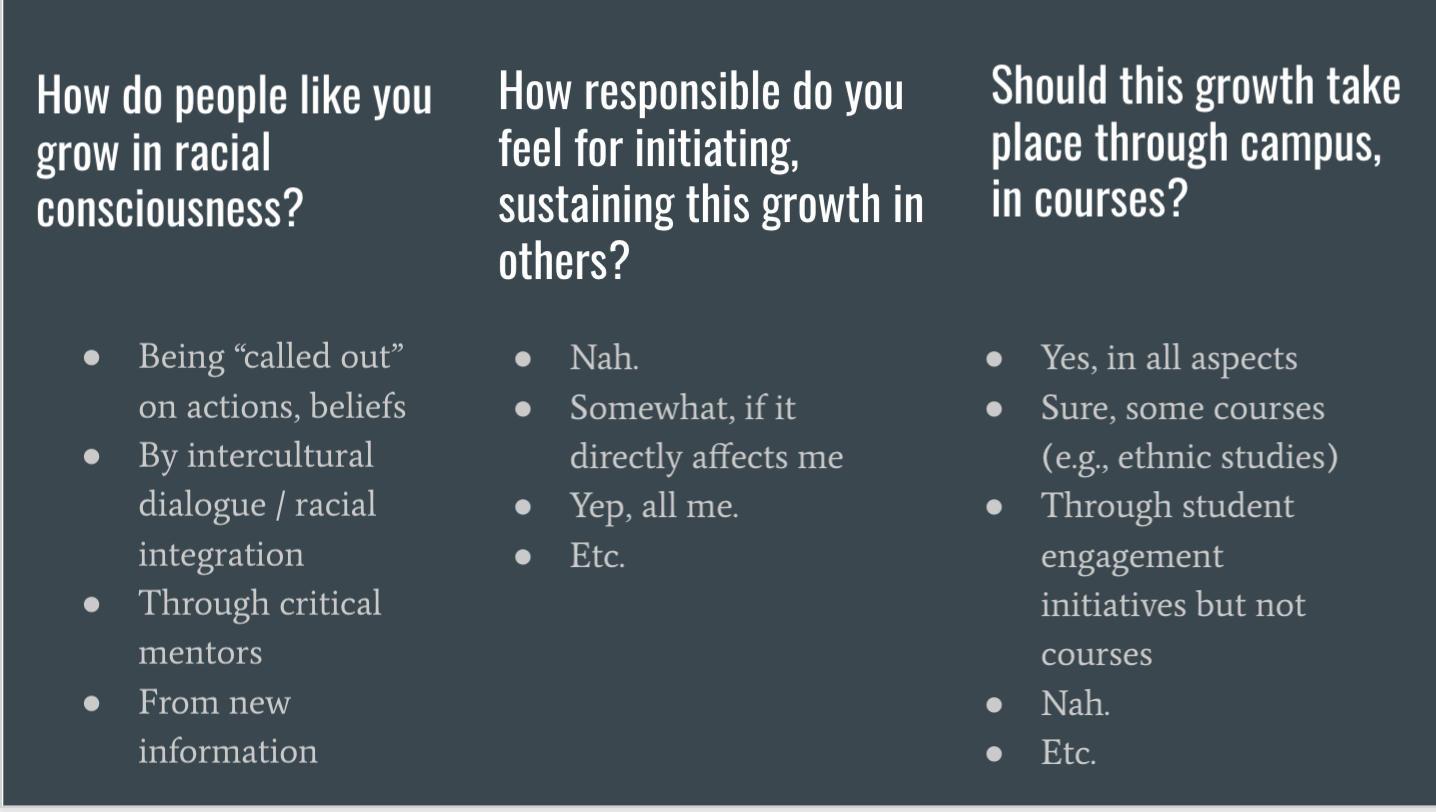
We then think about the kinds of actions that would follow from different configurations of answers. You can see one configuration in the series of green answers below. This person would likely be very vocal, all the time, and everywhere. Do you know anyone like this? Is this you? This person would also likely design courses and campus programing for explicit antiracist outcomes. The point here isn’t to evaluate this theory of change but to understand the actions that would follow from this particular configuration of answers.
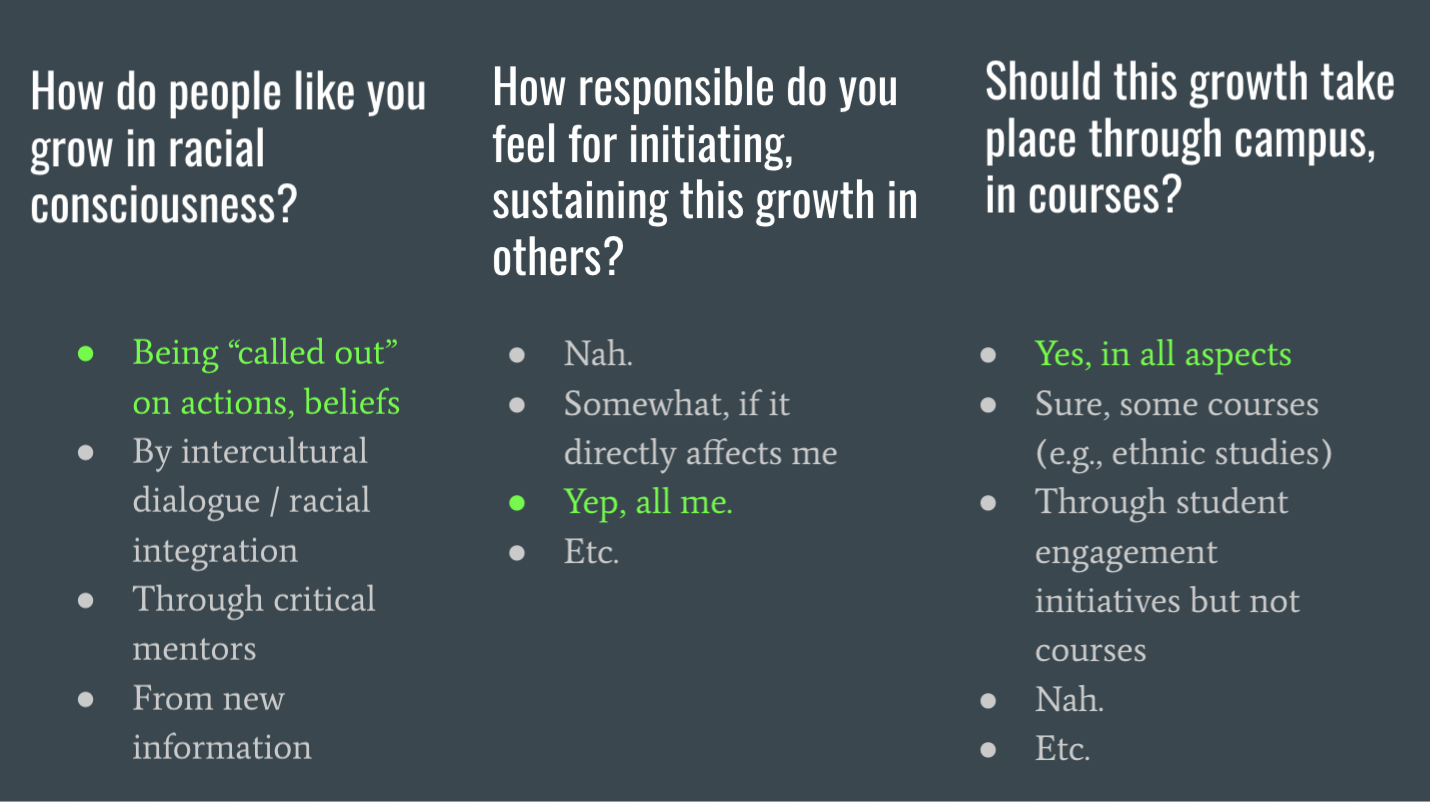
But then if you were to change just one answer, the ensuing actions would also change. In this case below, the red answer would shape the curricular and campus programming decision faculty and staff make. This person would not wrap all courses and programming around antiracist outcomes, even though the answers in the first two columns have not changed.
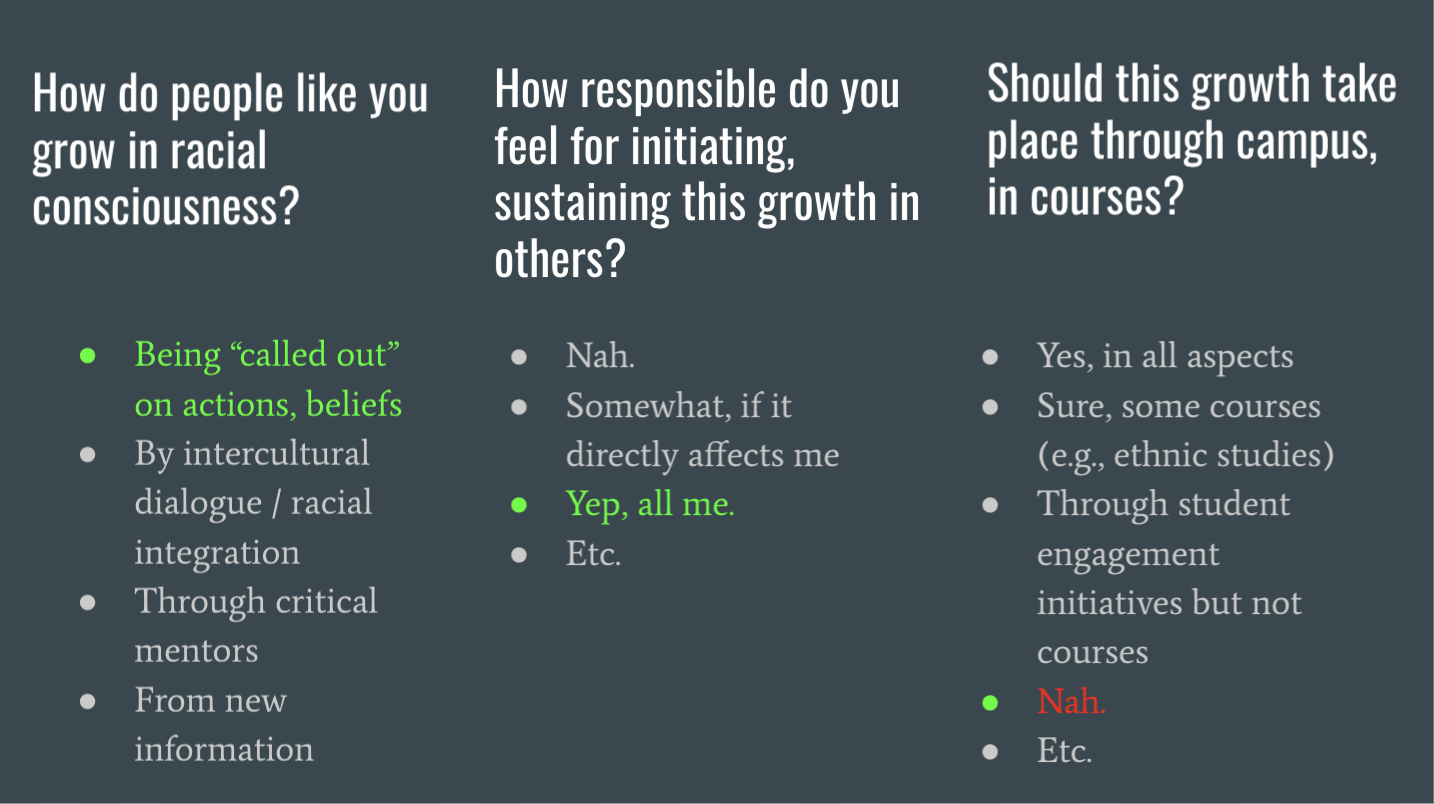
And there are other options too. In the configuration below, this person feels less responsible for initiating growth in others. This might mean they are less vocal about issues that do not directly impact them.
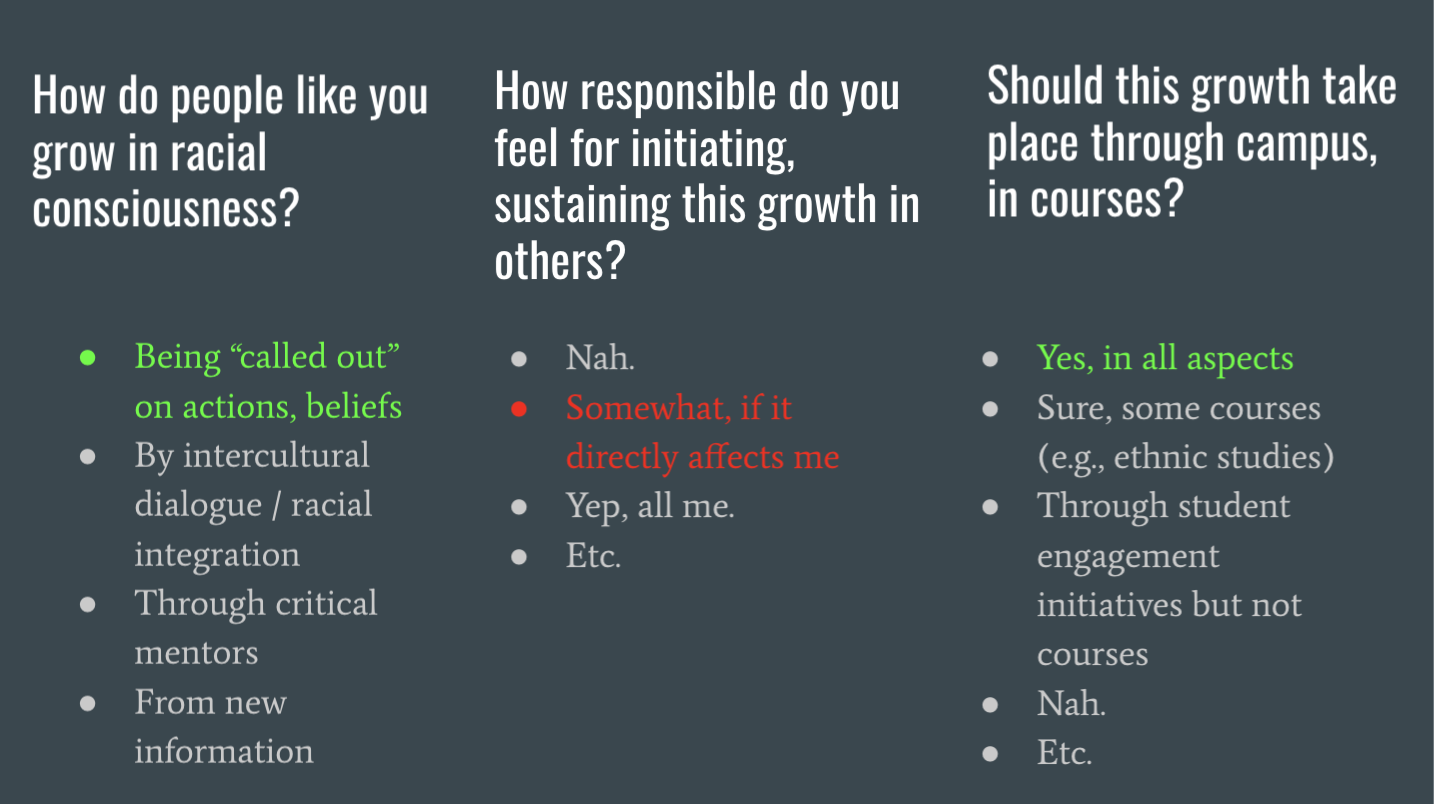
And so on. Once again, the point in this exercise is not to evaluate theories of change. Some of them might be right. Some of them might be wrong. And there are always contradictions among theories of change because they operate across many scales and temporalities (another point from Tuck). Similarly, the point is not to reach consensus about which set of answers is right (though that may be an important step in a different process). The point is to understand how different answers to key question will result in different actions. Colleagues may be very similar to one another with respect to how they answer these questions, but the actions that result may be very different. Or colleagues may be very different from one another with respect to how they answer these questions, and that is why their actions are different.
I imagine there are many ways to remix this exercise. Different sets of questions and answers could populate this matrix and shift the purpose of the activity. The phrase “racial consciousness” early on could be substituted with something else as well.
*Thanks to my collaborators Briona S. Jones and Sen Kim for co-facilitating this Race, Pedagogy, and Lit series.
Have you ever been writing a conference proposal but the call asks for stuff that doesn’t fit your proposal? Here’s one way I try to handle that. I insert a sentence like this before getting to the details.
Below I address A and B aspects of the proposal call. Since C and D aspects do not apply to this submission, I instead address E and F because they [reason]
I directly say what I’m not doing so they don’t have to wonder about it. But instead of just saying what I’m not doing, I let them know what I’m doing instead. I try to think about it like this: what’s the information they might have asked for if they better understood the kind of thing I’m proposing.
So instead of addressing the data sources in a call that assumes everything is “empirical,” I might address the ethical stance of the project instead.
Awe man, this uptempo Little Dragon cover by Conclave just made my day. And the video is just charming.
Ian Fink playing his piano at home. That’s it. That’s the album. And I love it.
Boggs readings you might have missed, loneliness in Carl Craig’s sound installation, an album we don’t deserve, and more. I had fun putting together this week’s Elements & Embodiment newsletter.
Carl Craig on why “Poppa Was a Rolling Stone” is a techno record:
Techno is about attitude. It’s like how rap music is about attitude and lifestyle. Punk was about attitude and lifestyle. Techno is really about an attitude because we don’t lock ourselves into only listening to techno all fucking day long. The attitude of techno is that kind of brashness, but that you’re doing something that can sound like it’s timeless, and also that it’s not from this earth. That’s what “Papa Was a Rolling Stone” is to me; at any point I can hear it, and it’s just the amount of space that’s being used, the grooves. It’s got a groove without playing a lot of notes. It actually probably has more of a Miles aesthetic: it’s not about the notes you play but the notes you don’t play. The amount of space that’s in between bass riffs, or that there’s a little bit of Rhodes, and there’s some horns with an effect on them. The thing that’s carrying it is the hi-hat and the low bass. So, that is really techno to me.
You all would not believe how many sentences in my articles are first dictated into a voice memo while working out. I swear: sweating + exhaustion induce clarity of thought.
“What time is it on the clock of the research project?” (R. N. Brown, personal communication, June 28, 2021)
Don’t say I never shared anything fun with you. Sample-Stitch: Reconstruct the Samples of Producers’ Beats.
What I'm reading, writing, listening to week of 06.27.21
##Reading
I’ve been reading some under-the-radar pieces related to Jimmy and Grace Lee Boggs, including:
“A Lifelong Search for Real Education,” where Detroit educator Julia Putnam reflects on how the Boggs shaped her ideas about education. This is a tender, moving piece because of excerpts like this, when Julia tells how it felt as a teenager to know that Jimmy was proud of her.
I was moved, touched that this man who knew nothing about me was proud of me. Had I been that starved for this kind of praise? I think so. My family praised me, but it was for things I was supposed to do—I was obedient, didn’t cause trouble, and my grades were fine. For that, my family was proud, appreciative. Jimmy was proud of me for going beyond that. He was proud because I cared about something other than myself. I’d never even thought to give myself credit for that. I was ready to put my time and energy toward a Detroit that I could be proud to live in.
Then there is “Another Education is Happening” from 2011 where Julia tells the story of how she was shaped as a teenager by Detroit Summer, the youth program organized by the Boggs. She drops this gem:
I had not even known that I craved being asked to do something important until I was actually asked.
I’ve been thinking about that sentence – and even its verb tenses – and texting it to people all week.
##Writing
I’m still moving forward, with frequent steps back, on an essay about theories of change in activist education scholarship. Here is how the focus is shaping up:
This essay, I reassert the importance of theories of change, and their ontologies and epistemologies, for contemporary scholar activism in education. For this task, I draw especially from decolonizing and Indigenous approaches to participatory action methodologies, for they have a great deal to teach us about this topic. While these ideas have long been central to scholar activism, I offer that these considerations are especially important in the early 21st century as scholar activists extend traditions and invent new formations to carry out their activist work, especially outside state-related, settler colonial institutions.
##Listening
Incredible head-nodding in the clouds soul from Goiânia, Brazil. It’s Corpo Possível by Bruna Mendez.
Conclave by Conclave, a group of rotating musicians “inextricably woven around the living, breathing rhythm.”
The group we don’t deserve is back with an album we didn’t know we needed. The group is SAULT. The album is NINE. And you should press play.
New SAULT. The group we don’t deserve 🎶
I had not even known that I craved being asked to do something important until I was actually asked.
Julia Putnam on when Jimmy and Grace Lee Boggs came to Renaissance HS recruiting for Detroit Summer.
Just learned about the Bush Foundation: “We offer grants and opportunities to people who think bigger and differently about problem solving in Minnesota, North Dakota, South Dakota and the 23 Native nations that share that geography.” Check them out.
